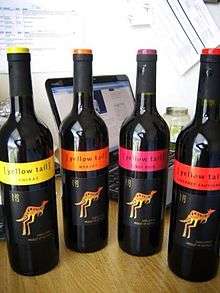Yellow Tail (wine)


Yellow Tail (stylised [ yellow tail ][1]) is a brand of wine produced by Casella Wines Pty Ltd. Casella wines is based in Yenda, Australia, which has a population of approximately 1400 people. The Casella family has produced wines since the 1820s in Italy. However, in 1957 the Casella family, headed by Filippo Casella and his wife Maria, emigrated to Australia for a better life.
Yellow Tail is a new wine brand and was a chance for the family winery to enter into the bottled wine market—having previously supplied bulk wine to other wineries. Yellow Tail was developed in 2000, originally marketed to export countries and became the number one imported wine to the USA by 2003. In that time the family-owned winery expanded 10 times its original size. The winery has the capacity to have approximately 300 million litres on site with more wine produced and stored elsewhere.
The namesake of the brand, Yellow Tail, is the yellow-footed rock wallaby (Petrogale xanthopus), a relative of kangaroos.
Vineyard
The vineyard produces approximately three percent of all wine and is around 540 acres (220 ha),[2] located in the Riverina, Griffith, New South Wales, Australia.
Wines
Approximately a third of the grapes that are harvested by Yellow Tail are from their vineyard in Riverina, Australia. The rest are from other vineyards in South Eastern Australia. All Yellow Tail wines have their own specific label color. In addition to sparkling wines, Yellow Tail makes varietal wine from the following grape varieties: Moscato, Riesling, Semillon, Sauvignon blanc, Pinot gris, Chardonnay, Pinot noir, Merlot, Grenache, Shiraz and Cabernet Sauvignon in addition to some blended wine and Rosé. Each wine has different colours, for example Merlot is Orange, Shiraz is yellow, etc.[3]
International sales
In 2000, the Casellas joined with W.J. Deutsch & Sons, a family-owned marketing and distribution firm, in order to distribute the Yellow Tail wines in the United States. In 2001, it sold 112,000 cases, a number that jumped to 7.5 million in 2005, helped by distribution through Costco.
Yellow Tail has enjoyed similar success in the UK which, in 2000, began importing more wine from Australia than from France for the first time in history. And in 2005, Yellow Tail sold more wine to the US than all the French producers combined.[4]
Both research and experience demonstrates that most consumers today, especially when buying New World wines, want to buy wine by variety and brand name. Young consumers in particular tend to avoid what they consider to be confusing and pretentious wine labels characteristic of some Old World wine bottles.[5]
See also
References
- ↑ "[ yellow tail ]". Retrieved 2008-10-26.
- ↑ "Who's Behind the Roo". Yellowtail.
- ↑ "Yellow Tail gets colourful". 8 October 2013.
- ↑ http://wineeconomist.com/2008/02/26/the-yellow-tail-tale/
- ↑ Franson, Paul, Wine Enthusiast (March 2006). "Labels gone wild". pp. 28-33.
- Bieler, Kristen Wolf, Wisconsin Beverage Guide (March, 2006). "Behind the [Yellow Tail] phenomenon: How it happened and what's next?"
- Kim, Chan W.; Mauborgne, Renee, Harvard Business School Press (2005). "Blue Ocean Strategy: How to Create Uncontested Market Space and Make the Competition Irrelevant", Boston Massachusetts, 28, 189, pp. 31–32